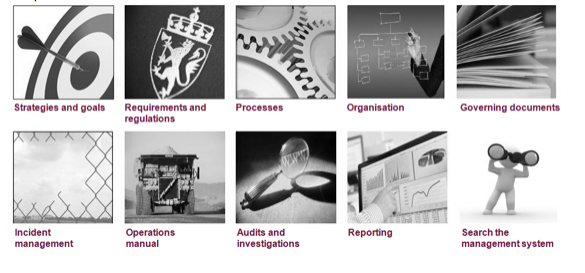Management systems often have a bad reputation among employees. If you look at a large organization and ask its employees about its management system, you are likely to get a negative or “non-caring” answer.
By: Tom Einar Nyberg, BPM Team Lead / Managing Consultant, Capgemini Norway, ten@capgemini.com
With the exception of a few interested employees, the management system is often seen as something that just “needs to be there”, but its usefulness and purpose is no longer evident. What once started as something with a defined value – grew into something that has forgotten its “roots”. So why is this – and how can we bring back the value that resides within?
.
Basic principles
Lets start with a basic principle: The management system must have a clear purpose. The system is there to provide valuable information, and support your employees – not the other way around!
The system should support the organization in doing “the right things”, and the employee in “doing things right”. The management system needs to connect everyday activities with the larger organizational purpose and goals. Your employees have job-duties to perform. Using the system should therefore guide and help them in performing that job. Your management system should make their working-life a little easier. You don’t need to use the system to accomplish everything you do, but the system needs to answer fundamental questions about the organisations strategy, management and operations.
The organization, customers, employees and processes
The organization connects to its customers and external environment through its products and services. Fundamental questions for the organization are:
What business are we in and what is our business model?
- Who are our customers and what products and services do we deliver to them?
- What are our values, competitive strategy and goals?
- What are the standards and requirements we must meet?
- How are we performing against our targets?
The employee is connected to the organization by the work he does every day. Fundamental questions for the employee are:
What are my responsibilities?
- Why am I doing these tasks?
- How do I perform them correctly?
- What are my goals and how am I performing?
All products and services are delivered to customers through the organizations processes. All work done by the employee is part of a process. Therefore – the “bridge” between your customers, your organization and the employees – are the processes in the organization. Since the management systems should both guide and support your employees’ activities – it is rational that the management system should be process oriented.
Where do management systems go wrong?
So with these basic principles and questions in mind – how can it all become so difficult? What tends to happen – is that the original purpose of the management system gets “overshadowed” by bureaucracy and the need for documentation. The information collected in the management system grows until it becomes a massive entity that needs large amount of resources just to keep it updated. This is typically the point where the system takes on its “necessary evil” status in the organization.
Employees will avoid delivering information into the system and will keep the information they really need on the “outside”. They do this typically because of the effort required to keep the system relevant and the requirements / bureaucracy that comes with it. Maintaining the system becomes its “own purpose” – and it starts demanding more from your employees than it gives back in value and usefulness. At this point, the system is no longer guiding or supporting your employees – and the information it contains quicly starts to loose its value and relevance. The management system has now lost its original purpose.
Bringing back the fundamentals – information value
So how do we bring back the value of the management system? In my view – this is a question of focus, flexibility and supportive technology. Focus on the fundamental questions that the management system needs to answer. Information in the system should help answer these questions – and guide / support your decisions and work activities. Information that is not used – has no value. Even worse – since information needs to be maintained, it always comes at “a cost”. So the value for the management system can be expressed as the usage value of its information, minus the cost of maintaining that same information.
Flexibility comes into play on several levels. When defining the scope and relevant sources of information in the system it is important to distinguish between information availability and information storage. Often the management system starts loosing value because the information that is useful to the employees is excluded from the system. This is caused by a conceptual mistake when defining the management system. The system should not been defined as a single “technological box” but as “a collection of modules” which are inter-connected.
The “information modules” should be structured according to relevant topics and may be supported by several technological platforms. Examples of typical topics are “Strategy and goals”, “Laws and requirements”, “Processes”, “Organisation” etc. Within a single module – you will find available all the relevant information – irrespective of where it is stored. One piece of information may be reused across several relevant modules. The availability of information is what gives value to the user – but the same information has different value in different contexts. For example – a document describing the organizations strategy will be available in the “Strategy and goals” module, but may also be reused in the “Organisation” and “Process” modules.
Information modules cuts across internal storage platforms and technology. Since the relevant information objects has different origins – this is a natural consequence. Trying to move all the raw information into a single storage solution will only increase the need for maintenance. Data quality and security should be managed in the individual storage systems according to relevant requirements. The management system – makes information available – it is not a single entity for data storage. You can compare this to browsing information on the internet. As a user – you are not concerned with the server, or site that holds the data – you just want the information available – easy, quick and convenient. The management systems value is dependent on “the availability of relevant information” in a user friendly manner.
Information governance based on relevance, format and value
In order to guide and support employees there needs to be governance over the relevant information in the management system. But the governance should focus on information relevance, format and value. Flexibility in data sources can potentially overload employees with information. Different processes, tasks and decisions – requires an adaptive information model. There needs to be a common structure – but there also needs to be flexibility built into this structure. The level of detail in the system will vary according to business requirements. For example, a complex process with multiple regulations, critical safety risks and complex execution will need to be described in more detail than a simple marketing process. The governance model will need to determine relevant information requirements based on several usage criteria.
- What are the external or internal requirements?
- What is the information need of the organization, employees or external users?
- What information is relevant and from what source?
- What is the required format and what level of detail is needed?
This puts information value “front-and-center” in terms of governance criteria – and focuses the management system on providing information that is valuable to the employee. The governance model should bring the management system back to its roots – and start working for – not against – the employees in the organization.

Author: Tom Einar Nyberg
Tom Einar Nyberg is the team lead for Business Process Management in Capgemini Norway. He has been working in the BPM area since 2006 and has been through multiple organizational BPM transformations. He has experience from a wide variety of sectors: Aviation, Banking, Transportation, Shipping, Oil & Gas, Public, and Telecom. Projects span across: process design and Lean improvement, performance management, BPM Center of Excellence, Corporate management systems, Governance and Strategic alignment
All articles are © 2015 by the authors.
The views and opinions expressed by our authors are those of our authors and do not necessarily reflect the official policy or position of IRM UK.
This article was featured in IRM UK’s Monthly E-newsletter. To subscribe please visit http://www.irmuk.co.uk/usefulinfo/enewsletter.cfm. Please note we are always on the look-out for new contributors so if you have an article you would like published please forward it to jeremy.hall@irmuk.co.uk for consideration.
IRM UK Strategic IT Training Ltd. 2nd Floor, Monument House, 215 Marsh Road, Pinner, Middlesex, HA5 5NE, Tel: +44 (0)20 8866 8366 E-Mail: customerservice@irmuk.co.uk Web: http://www.irmuk.co.uk



